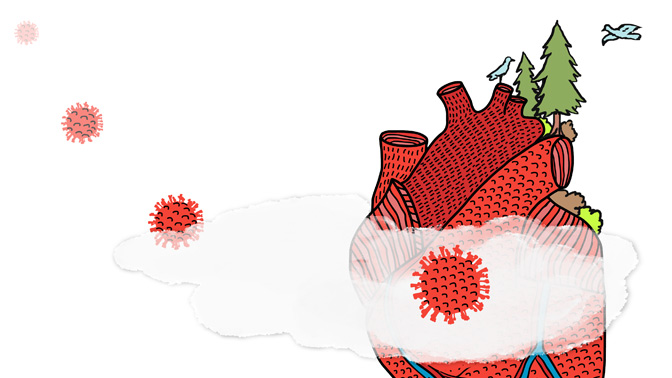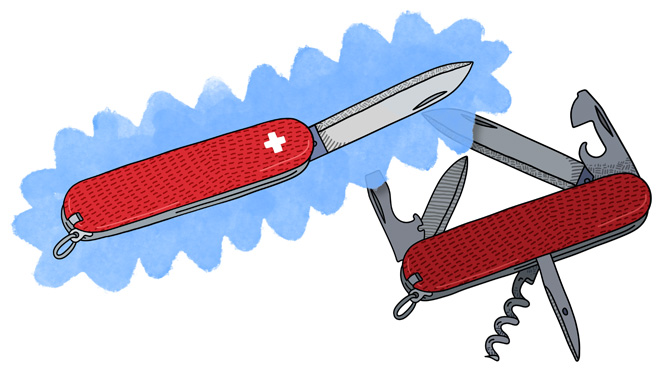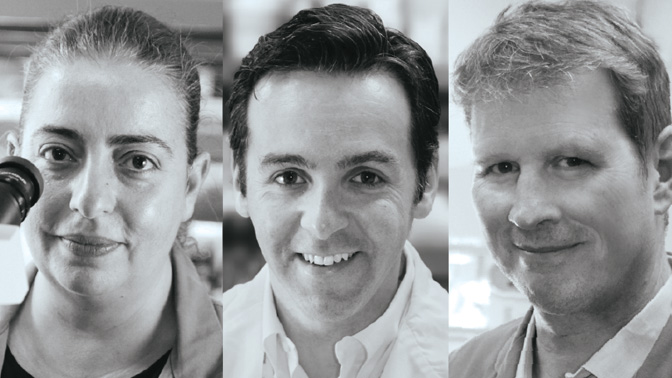
Peak Performance
Immune cells in the heart work hard to eliminate viruses that damage heart muscle
Have you been sick with a cold recently? That sore and scratchy throat is caused by infection with a cold virus, which is typically eliminated by the immune system in a week or so.
In some cases, however, cold and other viruses can infect the heart, which could lead to much more serious consequences. Viral infection can cause myocarditis, inflammation of the heart muscle that can compromise its ability to pump blood. Little is known about how the immune system plays a role in this disease.
To address this gap in knowledge, Dr. Slava Epelman led a study to examine the role of dendritic cells, a type of immune cell, in viral myocarditis. His research team found that at least five types of dendritic cells reside in the heart, where they trigger immune responses to help eliminate infections.
The team noted that the two most abundant types of dendritic cells in the heart were crucial for eliminating viruses that infect the heart. The absence of these cells not only dampened the anti-virus response, but also led to significant heart damage that impaired the organ’s pumping action—an early warning sign for heart failure.
These results suggest that dendritic cells are important gatekeepers of heart health: they quickly eliminate viral infections before the infections can cause full-blown heart failure. Understanding the role that these immune cells play in this process could help with the development of new therapies to treat heart infections.
Clemente-Casares X et al. Immunity. 2017 Nov 21;47(5):974-989. Supported by the Canadian Institutes of Health Research (CIHR), the Heart and Stroke Foundation, the March of Dimes Canada, the Ted Rogers Centre for Heart Research, the Heart & Stroke/Richard Lewar Centre of Excellence in Cardiovascular Research, the Peter Munk Cardiac Centre, the National Institutes of Health and the Toronto General & Western Hospital Foundation (TGWHF). M Cybulsky holds a Tier 1 Canada Research Chair (CRC) in Arterial Wall Biology and Atherogenesis.
 Treatment for Two
Treatment for Two
HIV drugs alter levels of a hormone that is critical to a healthy pregnancy
A healthy pregnant woman translates to a healthy baby. This is the reason that many women go to great lengths to improve their health once they become pregnant.
But as Dr. Lena Serghides discovered in two studies, women who are infected with the human immunodeficiency virus (HIV) face greater challenges when trying to ensure the health of their babies.
HIV-positive pregnant women are advised to take a drug regimen—commonly referred to as combination antiretroviral therapy (cART)—to prevent mother-to-child transmission of the virus. Unfortunately, these drug regimens are often associated with a number of adverse birth outcomes, including preterm delivery and low birth weight.
To better understand how these treatments affect birth outcomes, Dr. Serghides and her research team measured the levels of several different hormones in pregnant women, before and after they were randomly assigned to take two different cART regimens.
Her team found that levels of the hormone estradiol were decreased in women taking one type of cART regimen and increased in those taking the other. These changes were linked to significantly lower birth weight, suggesting that hormonal changes may contribute to the adverse birth outcomes for women taking cART.
Says Dr. Serghides, “The results of our study underscore the need for more research on the long-term effects of these regimens as they may affect fetal development by differentially altering hormone levels.”
McDonald CR et al. Clin Infect Dis. 2018 Jan 18;66(3):428-436 & Balogun KA et al. Clin Infect Dis. 2018 Jan 18;66(3):420-427. Supported by CIHR; the Ontario HIV Treatment Network G655; the Canadian Foundation for AIDS Research; the Global Alliance to Prevent Prematurity and Stillbirth; and Grand Challenges in Global Health: Preventing Preterm Birth Initiative. KC Kain holds a Tier 1 CRC in Molecular Parasitology.
 Tools of the Trade
Tools of the Trade
A new method enables scientists to better control the production of cell types
Jack of all trades, master of none. It can be nice to have many skills, but sometimes it’s better to focus on building expertise in one key area.
The same may be true when developing cell therapies with iPS and iPL cells, as Dr. Thomas Waddell and his graduate student Li Guo found. iPS cells are stem cells that can be used to make a wide variety of cell therapies; however, their use is limited because they could grow into unwanted cell types, including tumours.
To address these limitations, the research team (along with Dr. Andras Nagy from the Lunenfeld-Tanenbaum Research Institute) used an approach called ‘interrupted reprogramming’ to make iPL cells. In contrast to iPS cells, iPL cells can be coaxed into becoming only a restricted number of different cell types, depending on the type of cell that was used to make the iPL cell.
This method makes it easier to control which cell types can be produced and to create batches of cells that are more pure.
To explore the potential use of iPL cells to treat respiratory disease, the research team focused on a type of cell—known as a club cell—that is found on the inner surface of the lungs. They used their approach to convert club cells into iPL cells; then, they coaxed the iPL cells into becoming other types of lung cells, such as goblet cells, which produce a thick fluid that traps foreign substances in the lungs.
This method could be used to develop new cell-based therapies to speed up the healing process after lung injury or to repair donor lungs before transplantation.
Guo L et al. Stem Cell Reports. 2017 Dec 12;9(6):1780-1795. Supported by the Hospital for Sick Children Transplant and Regenerative Medicine Program, CIHR, the Ontario Research Fund and TGWHF. TK Waddell holds the Pearson-Ginsberg Chair in Thoracic Surgery and the Thomson Family Chair in Translational Research. A Nagy holds a Tier 1 CRC in Stem Cells and Regeneration.

Toronto General Hospital Research Institute (TGHRI) researchers featured in above stories are (L-R): Dr. Lena Serghides, TGHRI Scientist; Dr. Slava Epelman, TGHRI Scientist; and Dr. Thomas Waddell, TGHRI Senior Scientist.




